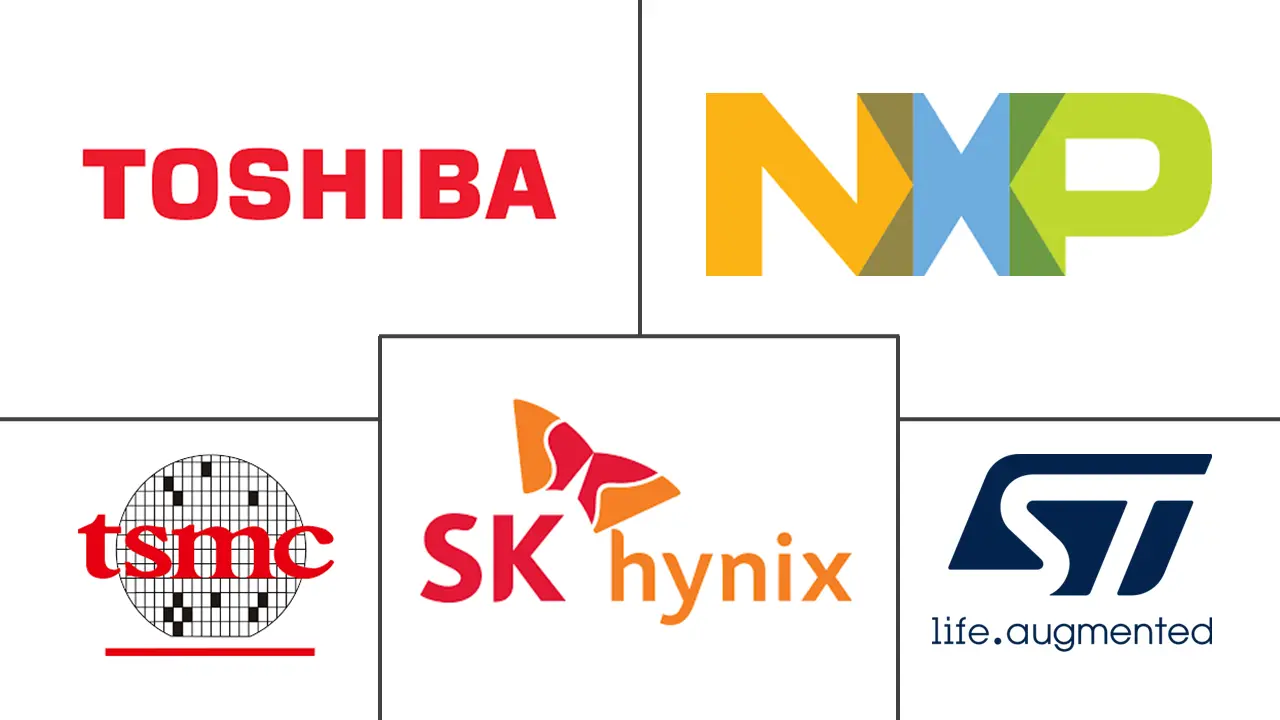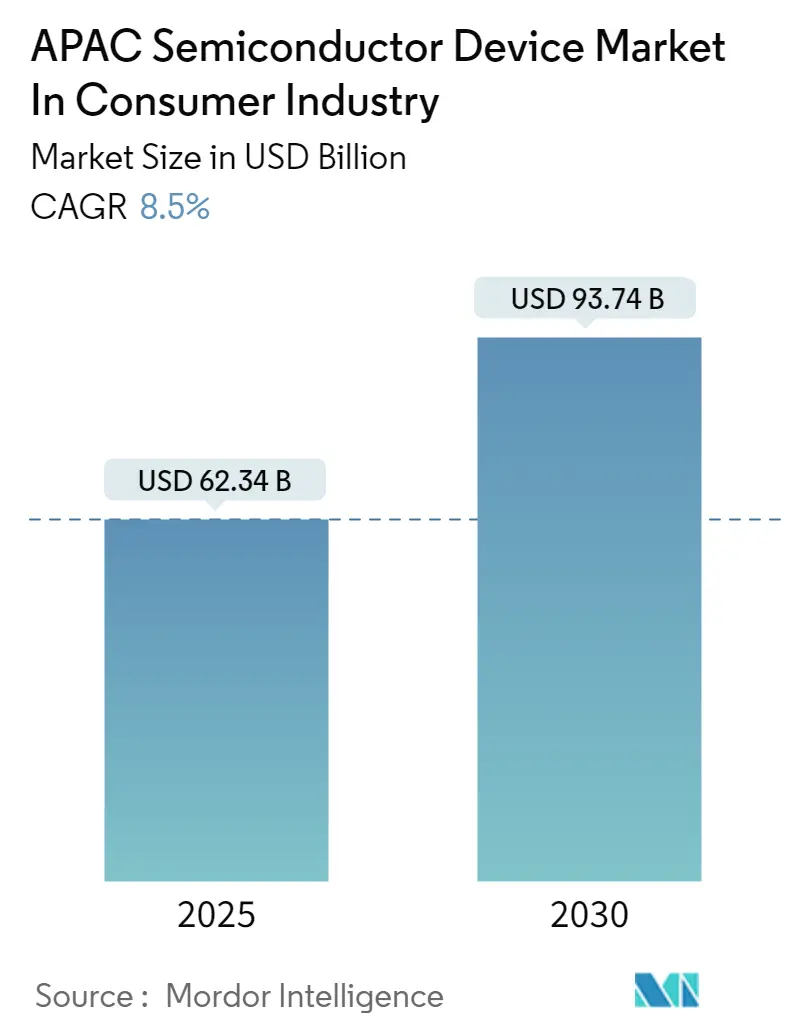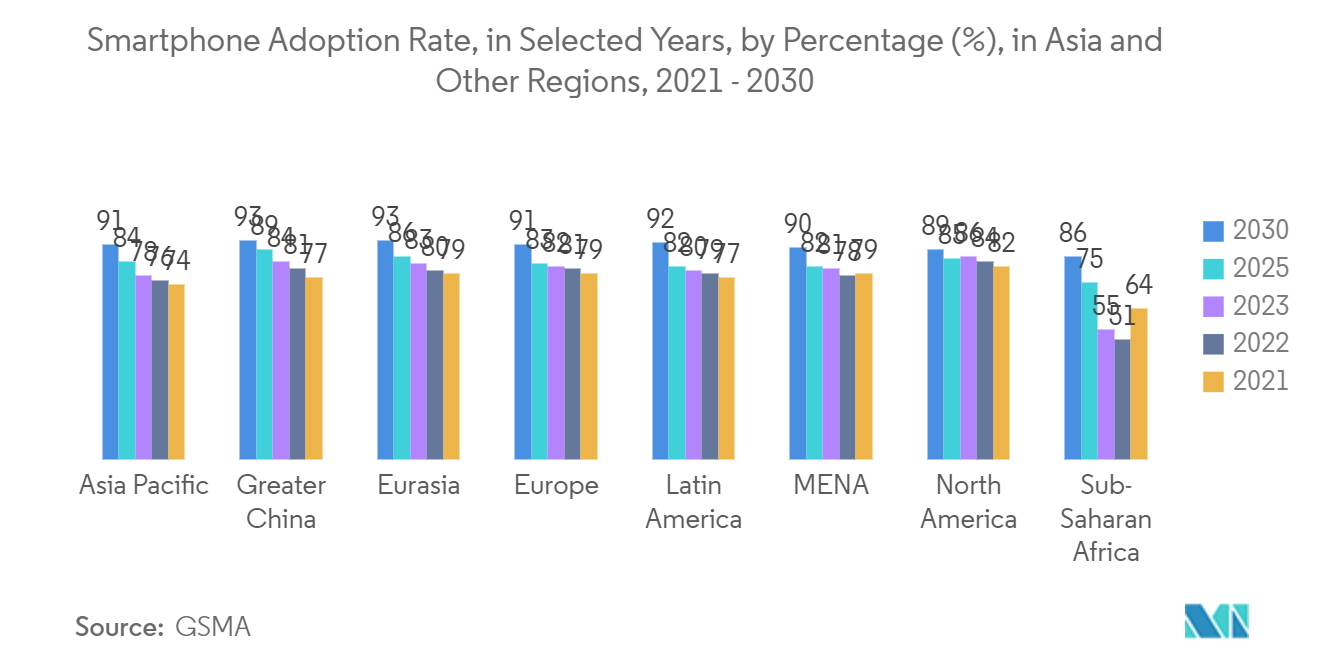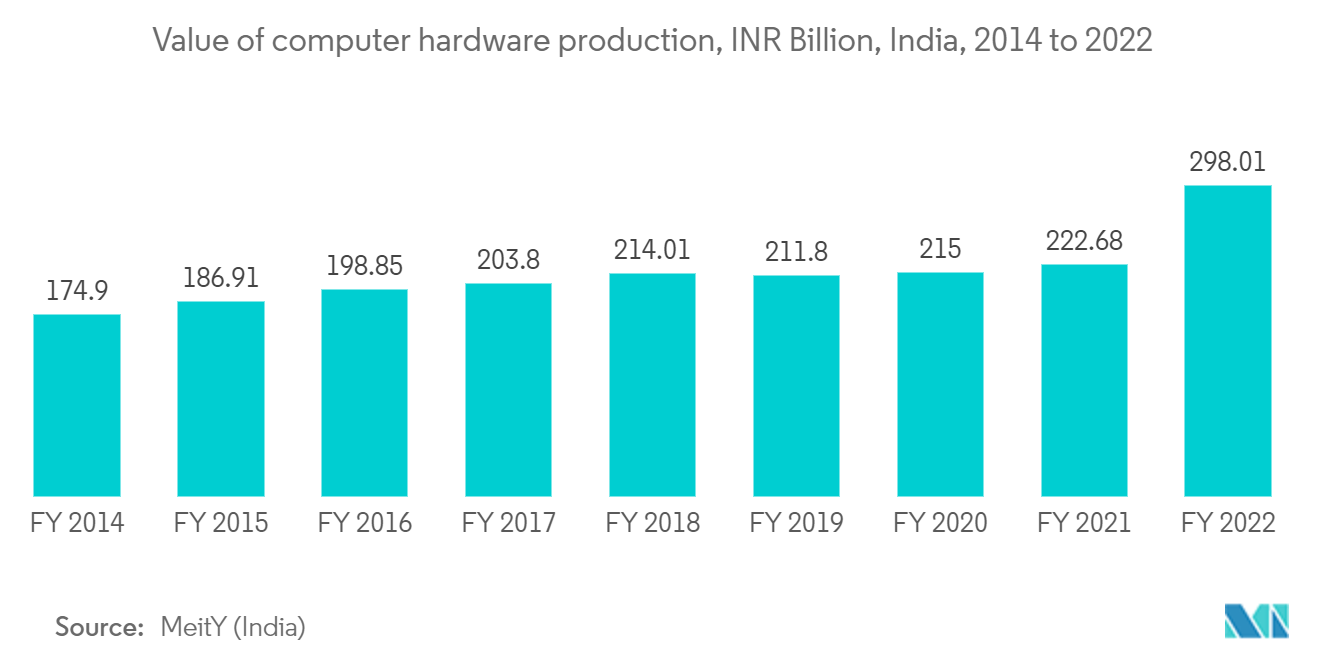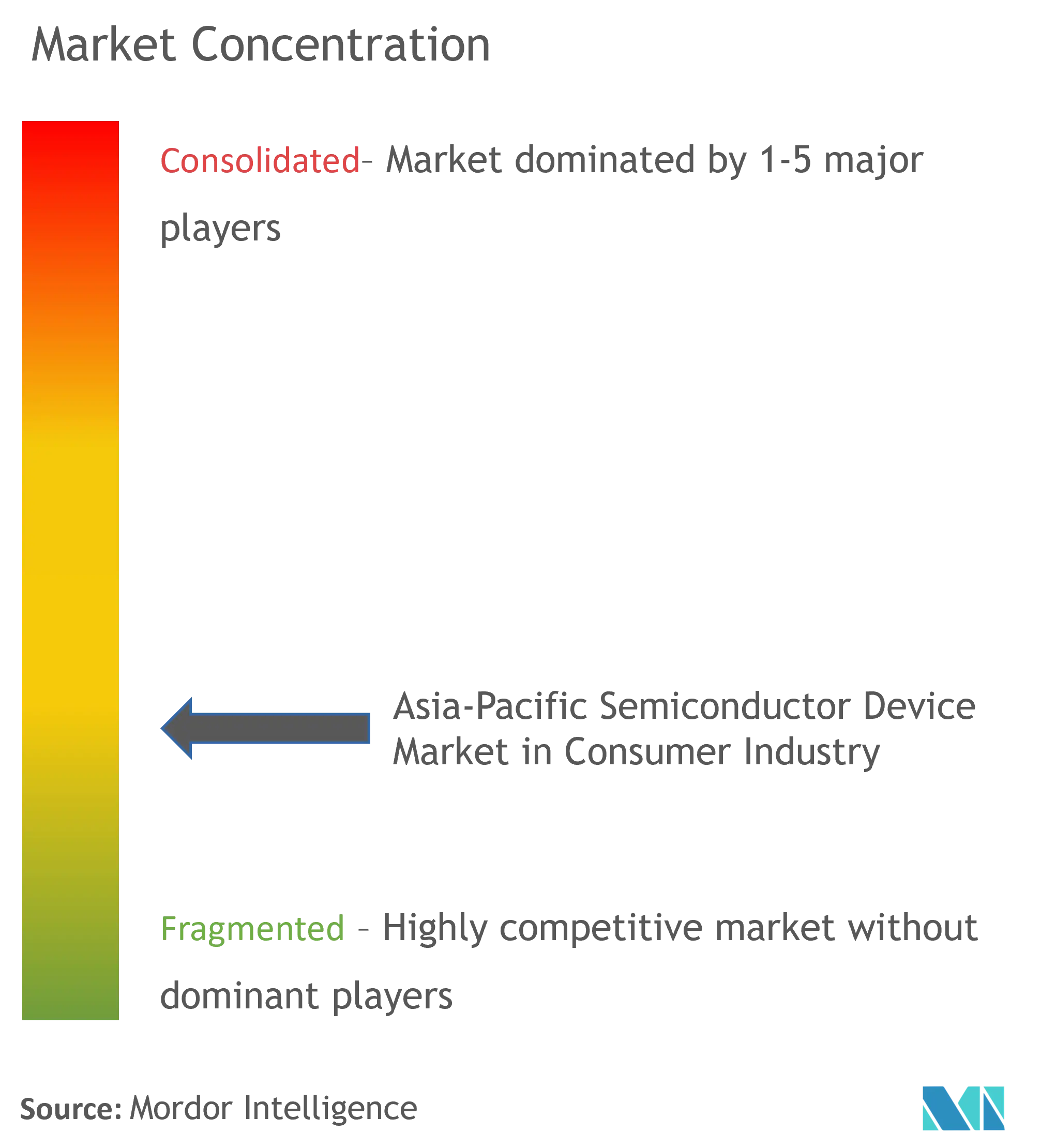APAC Semiconductor Device Market Analysis
The APAC Semiconductor Device Market In Consumer Industry is expected to grow from USD 62.34 billion in 2025 to USD 93.74 billion by 2030, at a CAGR of 8.5% during the forecast period (2025-2030).
Consumer electronics is the fastest-growing segment, contributing to market expansion. The expansion of smartphones, which is predicted to increase with population growth, is the key driving force for this market. Consumer electronics are driving the industry due to increased demand for products like tablets, smartphones, laptop computers, and wearable gadgets. As semiconductor technology advances, new market areas, like Machine Learning (ML), are rapidly being integrated.
- Semiconductor devices are widely used in home appliances to increase efficiency and reduce power consumption. These devices include diodes, transistors, and integrated circuits (ICs). For instance, diodes are used in refrigerators, air conditioners, and washing machines to convert AC voltage to DC voltage, thereby improving energy efficiency. The use of semiconductors in home appliances has made them more affordable and environmentally friendly, reducing energy costs and carbon emissions.
- According to the National Bureau of Statistics of China, In December 2022, retail sales of household appliances and consumer electronics in China totaled over CNY 79 billion (USD 10.88 billion). Further, Midea Group, a Chinese firm, was one of the world's largest household appliance companies in 2022, with a total sales value of roughly USD 51 billion. Gree Electric Appliances, another Chinese manufacturer, came in with a total sales value of almost USD 28 billion. Such huge sales of home appliances would create a demand for the studied market
- Smartphone demand has significantly increased in recent years, particularly in emerging economies like India. Additionally, the introduction of 5G-enabled smartphones and the burgeoning demand for telecom and auto automation systems are driving up the demand for 5G chipsets in developed economies. Therefore, it is assumed that the semiconductor devices may experience strong growth during the forecast period due to the rising production of 5G chipsets. The development of highly processing microchips or microprocessors is expected to attract increasing investments from market participants like Intel Corporation and Infineon Technologies AG, which is expected to drive up product demand in the semiconductor device market.
- On the flip side, the semiconductor industry is considered to be one of the most complex industries, due to more than 500 processing steps involved in the manufacturing and several products, but also the harsh environment it faces. For instacne, the volatile electronic market and the unpredictable demand. Depending on the complexity of the manufacturing process, there can be up to 1,400 process steps in the overall manufacturing of semiconductor wafers alone. Transistors are manufactured on the lowest layer, but the process is repeated as several layers of circuits are formed to create the final product. The complexity of manufacturing semiconductor devices is likely to restrain the growth of the studied market.
APAC Semiconductor Device Market Trends
The Integrated Circuits Segment is Expected to Drive the Market's Growth
- The rising proliferation of smartphones, feature phones, and tablets is driving the market. Analog ICs are used in a wide range of applications, including third and fourth-generation (3G/4G) radio base stations and portable device batteries. RFICs (radio frequency ICs) are analog circuits that usually run in the frequency range of 3 kHz to 2.4 GHz (3,000 hertz to 2.4 billion hertz) circuits that would work at about 1 THz (1 trillion hertz). They are widely used in cell phones and wireless devices. As they are under development, the analog IC market in this segment is expected to grow.
- Next-generation automobiles are expected to include features such as speech recognition, video and image compatibilities, and ICs in LED front lighting to provide an optimal driving experience. GPS tracking is now an essential component of automobiles, which drives the demand for analog circuitry to facilitate data transmission.
- Maruti Suzuki India, the country's top automaker by sales, plans to have six EV models by 2030. Further, the company plans to roll out the first battery EV from Maruti's plant in the state of Gujarat by the end of 2024. Similarly, in June 2023, Honda Motors announced its plans to offer an electric vehicle in India within the next three years as part of the Japanese automaker’s bid to capture the growing demand for EVs in a major global market. Such steps taken by global automobile manufacturers are anticipated to contribute to the growth of the market studied.
- China is also targeting the electric vehicles market, with more than one in three new car registrations in China being electric in 2023, as stated by IEA. Further, as per the National Development and Reform Commission (NDRC), more than 110 new NEV models are expected to be launched in 2024. For 2024, BYD, Huawei’s Aito, and Li Auto alone are planning to increase deliveries by 2.3 million vehicles. The Chinese government has also been formulating technology standards and industry guidelines for autonomous vehicles. Beijing became the country’s first city to allow open road tests for autonomous cars.
- The growing proliferation of the Industry 4.0 concept in the industrial sector is among the significant factors driving the growth of the studied market. For instance, the adoption of automation and robotics technologies has increased globally in recent years. According to the International Federation of Robotics, in 2023, global industrial robot installations were anticipated to grow by about 7% to more than 5,90,000 units. Furthermore, China is expected to remain the central market for installing industrial robots.
India is Expected to Witness a High Market Growth
- Discrete semiconductors are used in various electronic products, including smartphones. These semiconductors perform minor electronic functions, including power conversion, voltage regulation, data transmission, and high-definition digital displays in smartphones. Some of the many discrete semiconductors used in smartphones include transistors, diodes, and power devices.
- According to the India Cellular and Electronics Association (ICEA) projections, India's smartphone exports more than quadrupled to USD 11.1 billion (Rs 91,000 crore) in FY23, up from USD 5.48 billion (Rs 45,000 crore) the previous year, owing mainly to the Apple juggernaut. Furthermore, the Ministry of Information and Broadcasting secretary stated that India will have over 1.2 billion mobile phone users and 600 million smartphone users in 2022. Such massive exports of smartphones and a vast number of smartphone users would drive the demand for the studied market.
- Computer computers commonly use discrete semiconductor devices for various functions such as power conversion, voltage regulation, and signal processing. These devices are specified to perform electronic parts such as amplification, rectification, and switching. Examples of discrete semiconductor devices used in computers include diodes, transistors, and rectifiers. However, with the continuous scaling of semiconductor technology, integrated circuits are increasingly being used in place of discrete components due to their smaller size, lower cost, and higher performance.
- Further, according to MeitY (India), in the fiscal year 2022, the value of computer hardware production in India was estimated to be around INR 298 billion. This was an increase above the previous fiscal year's production value. The country's computer hardware production value has steadily increased. Further, according to the Department of Commerce, at the end of the fiscal year 2023, the export value for computer hardware from India was estimated to be approximately USD 554 million. Such a rise in computer production and exports would drive the market.
- Developing countries like India are also focusing on ambitions to create semiconductor devices manufacturing capability, and various investments from the vendors in the market are driving the market. For instance, in September 2022, Foxconn and local conglomerate Vedanta, based in Taiwan, invested USD 19.5 billion to set up a manufacturing facility in Gujrat, India. The facility is expected to be operational by 2024.
APAC Semiconductor Device Industry Overview
The APAC semiconductor devices market in consumer electronics is fragmented with several players like Intel Corporation, Kyocera Corporation, Toshiba Corporation, etc. The companies continuously invest in strategic partnerships and product developments to gain substantial market share. Some of the recent developments in the market are:
- May 2024: SK Hynix has unveiled ZUFS 4.0, a cutting-edge solution designed specifically for on-device AI applications in mobile devices, notably smartphones. Positioned as a flagship offering, the company anticipates that ZUFS 4.0 will not only solidify its leadership in AI memory within the NAND segment but also further leverage its success in high-speed DRAM, as seen with HBM.
- March 2024: Toshiba has introduced eight new products to its M4K Group within the TXZ+ Family of Advanced Class 32-bit microcontrollers. These microcontrollers are powered by the Cortex-M4 core with FPU. The latest additions come in four different package types and boast an enhanced flash memory capacity of 512KB/1MB, a significant upgrade from Toshiba's previous maximum of 256KB. Additionally, the RAM capacity has been boosted from 24KB to 64KB across the range.
APAC Semiconductor Device Market Leaders
-
STMicroelectronics NV
-
NXP Semiconductors NV
-
Toshiba Corporation
-
Taiwan Semiconductor Manufacturing Company (TSMC) Limited
-
SK Hynix Inc.
- *Disclaimer: Major Players sorted in no particular order
APAC Semiconductor Device Market News
- May 2024: Toshiba finished 300-millimeter wafer fabrication facility for power semiconductors and an office building at KagaToshiba Electronics Corporation in Ishikawa Prefecture, Japan, one of Toshiba’s key group companies. Toshiba will now proceed with equipment installation, aiming to start mass production in the second half of fiscal year 2024.
- Feb 2024: TSMC has unveiled plans to expand its operations in Japan, specifically in Kumamoto on the island of Kyushu. By the close of 2024, the company, in collaboration with local giants like Sony Group Corp. and Toyota Motor Corp., aims to commence the shipment of logic chips. These chips are destined for use in CMOS camera sensors and automotive applications. Notably, the Japanese government has earmarked a JPY 476 billion for this venture. These strategic moves are poised to significantly propel the segment's growth in the coming years.
APAC Semiconductor Device Industry Segmentation
A semiconductor device is an electronic component that relies on the electronic properties of semiconductor material for its function.
The Asia-Pacific semiconductor device market in consumer industry is segmented by device type (discrete semiconductors, optoelectronics, sensors, integrated circuits [analog, logic, memory, micro [microprocessors, microcontrollers, digital signal processors]), and by country (China, Japan, India, Korea, Taiwan). The report offers market forecasts and size in value (USD) for all the above segments.
| By Device Type | Discrete Semiconductors | |||
| Optoelectronics | ||||
| Sensors | ||||
| Integrated Circuits | Analog | |||
| Logic | ||||
| Memory | ||||
| Micro | Microprocessors (MPU) | |||
| Microcontrollers (MCU) | ||||
| Digital Signal Processors | ||||
| By Geography | Japan | |||
| China | ||||
| India | ||||
| South Korea | ||||
APAC Semiconductor Device Market In Consumer Industry Market Research Faqs
How big is the APAC Semiconductor Device Market In Consumer Industry?
The APAC Semiconductor Device Market In Consumer Industry size is expected to reach USD 62.34 billion in 2025 and grow at a CAGR of 8.5% to reach USD 93.74 billion by 2030.
What is the current APAC Semiconductor Device Market In Consumer Industry size?
In 2025, the APAC Semiconductor Device Market In Consumer Industry size is expected to reach USD 62.34 billion.
Who are the key players in APAC Semiconductor Device Market In Consumer Industry?
STMicroelectronics NV, NXP Semiconductors NV, Toshiba Corporation, Taiwan Semiconductor Manufacturing Company (TSMC) Limited and SK Hynix Inc. are the major companies operating in the APAC Semiconductor Device Market In Consumer Industry.
What years does this APAC Semiconductor Device Market In Consumer Industry cover, and what was the market size in 2024?
In 2024, the APAC Semiconductor Device Market In Consumer Industry size was estimated at USD 57.04 billion. The report covers the APAC Semiconductor Device Market In Consumer Industry historical market size for years: 2019, 2020, 2021, 2022, 2023 and 2024. The report also forecasts the APAC Semiconductor Device Market In Consumer Industry size for years: 2025, 2026, 2027, 2028, 2029 and 2030.
Our Best Selling Reports
APAC Semiconductor Device Market In Consumer Industry Industry Report
Statistics for the 2025 APAC Semiconductor Device In Consumer Industry market share, size and revenue growth rate, created by Mordor Intelligence™ Industry Reports. APAC Semiconductor Device In Consumer Industry analysis includes a market forecast outlook for 2025 to 2030 and historical overview. Get a sample of this industry analysis as a free report PDF download.

